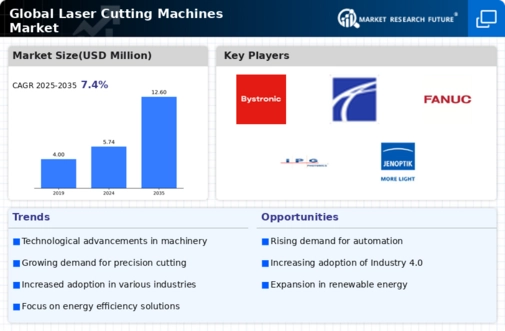Top Industry Leaders in the Laser Cutting Machines Market

The global market for laser cutting machines is characterized by dynamic growth, driven vigorously towards 2030. In this rapidly expanding arena, established industry leaders, agile contenders, and innovative entrants engage in intense competition, each crafting distinctive strategies to secure their positions. Revealing the playbooks of these entities unveils the intricate dance of competition within the market.
Strategic Approaches of Key Players: Precision Targeting and Diversification
Prominent players in the industry, such as Coherent, Inc., Jenoptik Laser GmbH, Bystronic Incorporated, Epilog Laser Inc., IPG Photonics Corporation, Trumpf GMBH, Amada Miyachi Inc, MKS Instruments, LancerFab Tech Pvt. Ltd, Jiangsu Dajin Laser Science and Technology Co., Ltd, Alpha Laser, Xenetech, Universal Laser Systems, Trotec Lasers, and Han’s Laser Smart Equipment Group Co., Ltd, among others, employ varied strategies for market dominance.
Industry giants like IPG Photonics, Trumpf, and Amada Miyachi Inc. leverage their established reputations and robust R&D capabilities. They prioritize technologically advanced machines, catering to demanding applications in aerospace, automotive, and medical sectors. For instance, IPG Photonics utilizes its laser source expertise to offer powerful fiber lasers, while Trumpf focuses on automation and software integration, showcasing sophisticated cutting heads and intuitive interfaces.
Challengers like MKS Instruments and Han's Laser pursue a different path, targeting price-conscious segments by offering cost-effective machines tailored to smaller fabrication shops and emerging markets. LancerFab Tech, for instance, leverages its Indian base to provide competitively priced machines meeting local needs.
Diversification is a common strategy across player categories. Companies are expanding their portfolios beyond standard flat sheet cutting into 3D laser cutting, pipe and tube cutting, and micromachining to cater to specialized needs and broaden their customer reach. Universal Laser Systems excels in micromachining applications, attracting manufacturers in the medical device and electronics sectors.
Market Share Analysis: A Complex Puzzle
Analyzing market share in this dynamic landscape requires a nuanced approach, considering factors such as technology leadership, regional penetration, application expertise, and the price-quality mix. Companies like Bystronic and Prima Industrie make waves with advanced cutting head technologies, while others like Han's Laser strategically focus on expanding their Asian presence.
Understanding specific industry requirements empowers players to tailor solutions, as demonstrated by Trotec Lasers' success in the wood and textile cutting segments. Balancing affordability with machine capabilities is crucial, especially in cost-sensitive segments, with companies like Amada Miyachi catering to both budget-conscious and high-end needs.
New and Emerging Trends: A Glimpse into the Future
The laser cutting landscape is continually evolving with trends such as the dominance of fiber lasers, integration of artificial intelligence, convergence of additive manufacturing, and a focus on sustainability. Fiber lasers, with their efficiency and low maintenance requirements, are eclipsing other laser types, with companies like IPG Photonics capitalizing on this shift.
Artificial intelligence is transforming machine utilization and reducing downtime, as exemplified by Trumpf's TruLaser Series 1000. Hybrid machines combining laser cutting and additive manufacturing capabilities are emerging, opening up new possibilities for design and fabrication, as seen in Xenetech's MetalX system. Sustainability is gaining traction, with energy-efficient machines like Bystronic's ByStar Fiber catering to environmental concerns.
Overall Competitive Scenario: A Dynamic Landscape
The laser cutting machines market is a tapestry woven with ambition, innovation, and fierce competition. Established players face constant challenges from nimble newcomers, and technological advancements reshape the landscape. Understanding key player strategies, market share analysis factors, and emerging trends is crucial for navigating this dynamic terrain. As fiber lasers reign supreme, AI enhances efficiency, and sustainability becomes paramount, the laser cutting market promises a thrilling ride, with players vying for dominance in a future ever-shaped by the brilliance of focused light.
Industry Developments and Latest Updates:
Coherent, Inc. (NASDAQ: COHR):
- Date: June 2023
- Development: Coherent launched the PowerLine R+ series, a new line of high-performance CO2 laser sources for industrial cutting applications. These lasers offer increased power, improved beam quality, and enhanced reliability, making them ideal for cutting thick metals and advanced materials.
Jenoptik Laser GmbH:
- Date: September 2023
- Development: Jenoptik partnered with TRUMPF to develop a new fiber laser cutting system for micromachining applications. This system combines Jenoptik's expertise in ultra-short pulse lasers with TRUMPF's cutting technology to achieve highly precise and delicate cuts on materials like glass, ceramics, and semiconductors.
Bystronic Incorporated:
- Date: October 2023
- Development: Bystronic released a new software update for its ByStar fiber laser cutting machines. The update includes features like collision avoidance and intelligent process optimization, aimed at improving productivity and reducing waste.
Epilog Laser Inc.:
- Date: November 2023
- Development: Epilog launched the Fusion Pro laser system, offering a combination of CO2 and fiber laser cutting capabilities in a single machine. This caters to a wider range of materials and applications, making it ideal for job shops and small businesses.

